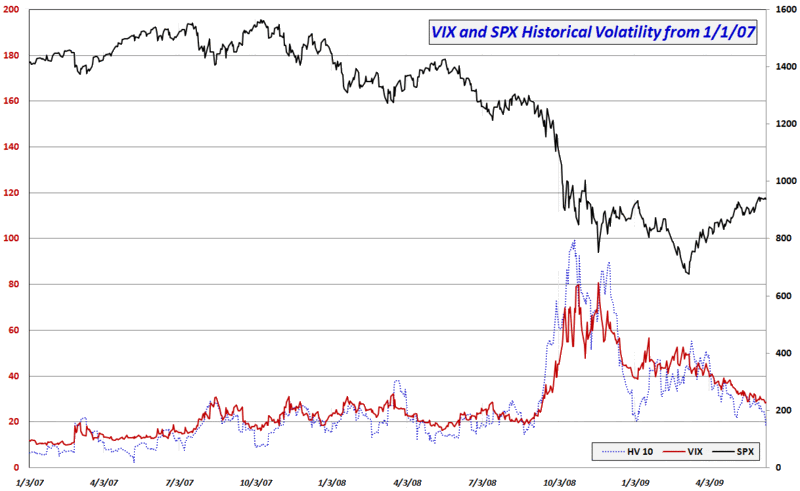Historical Volatility Continues to Plummet
Further to this morning's pre-market post, Volatility in Context with VIX at Pose-Lehman Low, today’s 0.35% drop in the SPX means that it has now been four days since the S&P 500 index has moved more than 0.35%.
The range-bound trading is taking a heavy toll on historical volatility (HV), with today’s action pushing the 10 day HV in the SPX down from 21.54 to 18.10 – the lowest reading since September 3, 2008.
The graphic below attempts to put the current historical volatility levels into the context of the past 2 ½ years. Note that the current 10 day HV of 18.10 fits right in the middle of the range for this measure during 2007 (a year of very low volatility) and the pre-Lehman portion of 2008. In fact, given the recent historical record, I would be quite surprised to see 10 day HV fall any farther than the current level for at least another month or two.
Of course the VIX can continue to decline in the absence of falling volatility, but at some point historical volatility begins to provide some semblance of a floor below which the VIX is unlikely to remain.
On the other side of the coin, investors should also be aware that it has now been 26 sessions since the VIX was above the 35 level. If there is a catalyst (such retail sales numbers, housing data, industrial production statistics, Treasury auction results, the FOMC meeting in two weeks, etc.) that will change the volatility equation, then it is reasonable to look to 35 – not 40 or 50 – as the target for a VIX spike.
Finally, with volatility expectations shrinking almost on a daily basis, those who may be interested in speculative buying VIX out-of-the-money calls might find them a lot cheaper than anticipated – and perhaps a lot cheaper than they will be in another week or two.

[graphic: VIXandMore]


5 comments:
Hi Bill, the SPX is quite flat since a few days, so it's quite normal for historical volatility to go down. VIX measures the premium of out-of-the-money options treated on the CBOE hence it can't go down that quick.
Something else: i've been thinking about these ratios i discussed with you last week. Besides the issue that SPX:VIX amounts to divide a price by a yield, i've considered SPX:CPCE instead.
CPCE is the "equity" put/call ratio thus it considers all the equity options treated during a given day and constitute some sort of "instantaneous volatility" which is a bit higher than the one obtained by VIX. Especially, one may look at CPC:VIX and CPCE:VIX which should display flat areas where instantaneous and implicit volatilities match each other separated by transition zones where both measure of volatility diverge.
Could these divergences be explained by saying that people in CBOE concentrate on in-the-money options thus anticipate minor changes in the near future ? What is your sentiment on this issue ? Best,
--
Laurent
Vovor,
I absolutely like the long straddle play here.
Laurent,
I am a big fan of CPCE (less so of CPC) and follow these fairly closely. For the most part these are positively correlated with the VIX, but there are divergences. The work I've done with the VIX:CPCE ratio definitely shows it has some value as a market timing tool, but I can't say that I trade off of this ratio.
Your theory about ITM options is an interesting one.
I'll have to put this subject back into my R&D queue and see what I can come up with. (Maybe it's time I hired an intern so I could trade, write a book and publish a newsletter -- yet still have some time for some more new research...)
Thanks for posting your thinking here.
Cheers,
-Bill
At a loss at how you keep encouraging people to be bearish on the general stock market when the market keeps contradicting your blog entries.
I am definitely on the wrong side of today's market move (so far), but I am not yet convinced that SPX 950 will fail hold at the end of the day (which is where I take most of my signals from.)
Right now the market is acting bullishly to all types of market news -- good, bad or neutral. Also investors continue to buy on the dip without worrying about the consequences of being wrong.
Until those two things change, the markets will likely go up -- BUT I believe the risk/reward profile of many long positions has deteriorated with the recent move up.
I still have long positions (mostly emerging markets and commodities) and will be glad to change my mind if the market continues to move up, but it will take a decisive move over 950 for me to flip back to bullish.
Cheers,
-Bill
Post a Comment